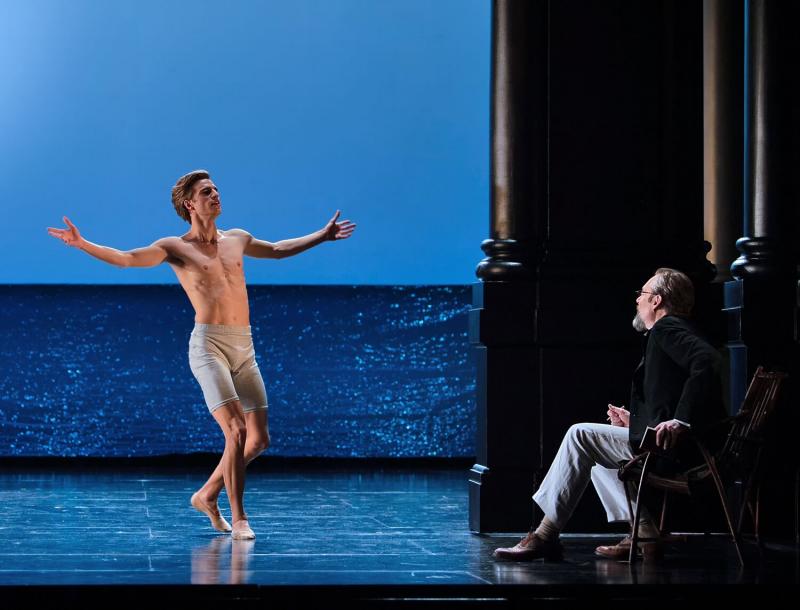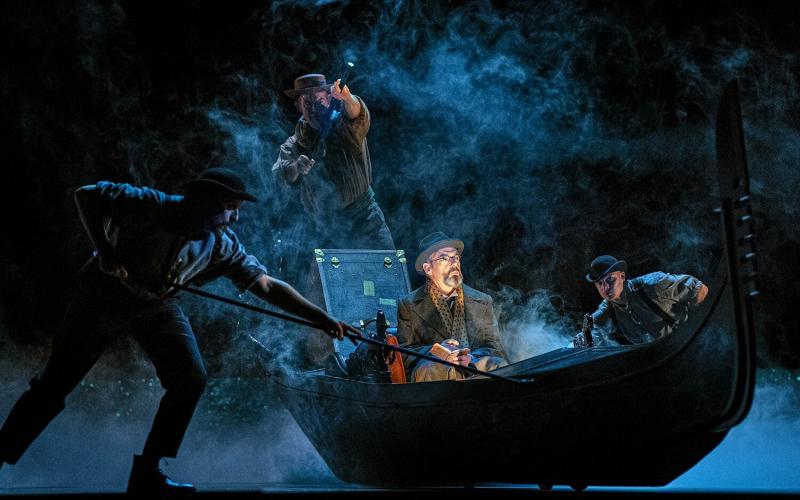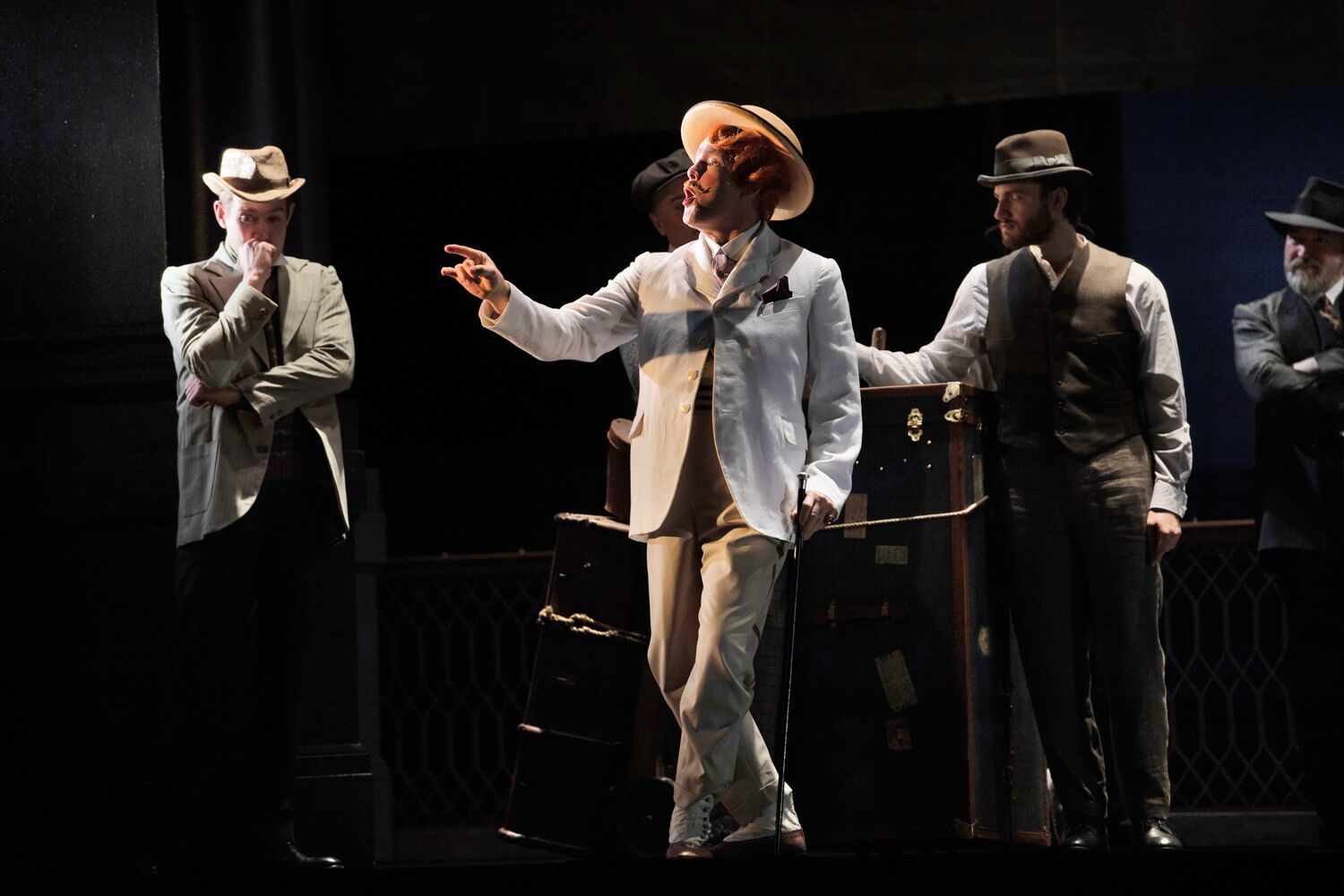Death in Venice, Royal Opera review – expansive but intimate evocations | reviews, news & interviews
Death in Venice, Royal Opera review – expansive but intimate evocations
Death in Venice, Royal Opera review – expansive but intimate evocations
David McVicar brings light and movement to gloomy Venice, but holds psychological focus

Death in Venice is usually a dark and claustrophobic affair. It lends itself to small-scale staging with minimal props and suggestive, low-key lighting. But for this new production at the Royal Opera, director David McVicar has taken a different approach. He has used all the resources at the company’s disposal to create a more expansive vision.
The set (designer Vicki Mortimer) is a series of concentric arches, their classical columns giving a foreshortening effect. But the columns move, left and right, creating a range of spaces and settings. The columns also move as part of the choreography, a visually unsettling effect that allows the literal spaces to take on psychological dimensions. And that seems to be the main idea here. Costumes and props are all faithful to the early 20th-century setting, and Venice is evoked through full-sized gondolas (pictured below) and stonework arcades. But otherwise much is left to the imagination.  Lighting (designer Paule Constable) is used evocatively. The beach scene has just a strip of blue backdrop to represent the sea, but comes alive through the low-level sun illuminating the action. The hotel scenes, too, are bathed in low sun, but now filtered through louver blinds. Choreography is an important part of this opera. Tadzio, the object of Aschenbach’s desires, is a mute role, danced with nonchalant elegance by Leo Dixon. But this production takes the dance element further, with choreographer Lynne Page transforming many of the crowd scenes. The choreography is classical, with broad gestures, all in keeping with the scale of the production. The Games of Apollo scene, where Aschenbach imagines the children’s beach play as Olympian games, is presented without fantasy imagery, relying on the dancing for evocation – which works beautifully. However, the sun god Apollo gets short-changed without a costume, presiding in just his swimmers. Fortunately, Tim Mead is a commanding presence, his countertenor suitably strident. The cast list is two pages long, but the opera usually seems like a two-hander, between the tenor role of Aschenbach (Padmore) and the baritone (Gerald Finley, pictured below), who plays seven of the characters that he meets in Venice, each a different manifestation of death. But the broader scale of this production breaks up that intimacy and brings many of the smaller roles – all excellently played – to the fore. Finley’s impressive acting is a mixed blessing too: He embodies each of the roles so well – the fop on the ferry, the barber, the leader of the circus troupe – that it is easy to forget that we are meant to be inferring links between them.
Lighting (designer Paule Constable) is used evocatively. The beach scene has just a strip of blue backdrop to represent the sea, but comes alive through the low-level sun illuminating the action. The hotel scenes, too, are bathed in low sun, but now filtered through louver blinds. Choreography is an important part of this opera. Tadzio, the object of Aschenbach’s desires, is a mute role, danced with nonchalant elegance by Leo Dixon. But this production takes the dance element further, with choreographer Lynne Page transforming many of the crowd scenes. The choreography is classical, with broad gestures, all in keeping with the scale of the production. The Games of Apollo scene, where Aschenbach imagines the children’s beach play as Olympian games, is presented without fantasy imagery, relying on the dancing for evocation – which works beautifully. However, the sun god Apollo gets short-changed without a costume, presiding in just his swimmers. Fortunately, Tim Mead is a commanding presence, his countertenor suitably strident. The cast list is two pages long, but the opera usually seems like a two-hander, between the tenor role of Aschenbach (Padmore) and the baritone (Gerald Finley, pictured below), who plays seven of the characters that he meets in Venice, each a different manifestation of death. But the broader scale of this production breaks up that intimacy and brings many of the smaller roles – all excellently played – to the fore. Finley’s impressive acting is a mixed blessing too: He embodies each of the roles so well – the fop on the ferry, the barber, the leader of the circus troupe – that it is easy to forget that we are meant to be inferring links between them.
Mark Padmore is on similarly excellent form as Aschenbach. Padmore doesn’t do much opera, but this role is perfect for him. As a recitalist, he is an acquired taste, often sacrificing beauty of tone for dry, almost spoken declamation. But that is exactly what Britten is looking for here. Many of the scenes are just Aschenbach to the audience, giving his inner monologue in bare recitative, with just a few percussion instruments beneath. Padmore is able to bring acute emotion to these scenes, without extravagance or lyricism, drawing the scale of the drama back down to the personal level.
Richard Farnes leads a clear and focussed reading of the score. The percussion section of the Royal Opera House Orchestra gets a rare chance to shine, with the vibraphone, glockenspiels and piano particularly impressive. Britten’s evocation of gloomy, stricken Venice relies heavily on the lower strings, and their tone here is dark and focussed throughout. A backstage chorus bolsters the cast, and they often come out into the auditorium, giving extra impact to the often raucous crowd scenes. Each of those is a memorable moment, but the greatest strength of this production is the intimacy of Aschenbach’s monologues, all delivered with tender and often anguished emotion by Padmore: This Death in Venice is an ensemble piece, but he’s definitely the star of the show.
The future of Arts Journalism
You can stop theartsdesk.com closing!
We urgently need financing to survive. Our fundraising drive has thus far raised £33,000 but we need to reach £100,000 or we will be forced to close. Please contribute here: https://gofund.me/c3f6033d
And if you can forward this information to anyone who might assist, we’d be grateful.

Subscribe to theartsdesk.com
Thank you for continuing to read our work on theartsdesk.com. For unlimited access to every article in its entirety, including our archive of more than 15,000 pieces, we're asking for £5 per month or £40 per year. We feel it's a very good deal, and hope you do too.
To take a subscription now simply click here.
And if you're looking for that extra gift for a friend or family member, why not treat them to a theartsdesk.com gift subscription?
more Opera
 Help to give theartsdesk a future!
Support our GoFundMe appeal
Help to give theartsdesk a future!
Support our GoFundMe appeal
 Best of 2024: Opera
Comedy takes gold over a year rich in standout performance
Best of 2024: Opera
Comedy takes gold over a year rich in standout performance
 La rondine, LSO, Pappano, Barbican review - sumptuous orchestral playing in an underrated score
Puccini's 100th anniversary celebrated in style
La rondine, LSO, Pappano, Barbican review - sumptuous orchestral playing in an underrated score
Puccini's 100th anniversary celebrated in style
 L’étoile, RNCM, Manchester review - lavish and cheerful absurdity
Teamwork to the fore in a multi-credit operatic comedy
L’étoile, RNCM, Manchester review - lavish and cheerful absurdity
Teamwork to the fore in a multi-credit operatic comedy
 The Pirates of Penzance, English National Opera review - fresh energy in clear-sighted G&S
Tenor lead shines, and conductor finds new beauties in Sullivan's score
The Pirates of Penzance, English National Opera review - fresh energy in clear-sighted G&S
Tenor lead shines, and conductor finds new beauties in Sullivan's score
 Rigoletto, Irish National Opera / Murrihy, Collins, NCH Dublin review - greatness everywhere
Sheer perfection in Soraya Mafi’s Gilda and an Irish mezzo’s Berlioz
Rigoletto, Irish National Opera / Murrihy, Collins, NCH Dublin review - greatness everywhere
Sheer perfection in Soraya Mafi’s Gilda and an Irish mezzo’s Berlioz
 The Elixir of Love, English National Opera review - a tale of two halves
Flat first act, livelier second, singers not always helped by conductor and director
The Elixir of Love, English National Opera review - a tale of two halves
Flat first act, livelier second, singers not always helped by conductor and director
 The Sound Voice Project, Linbury Theatre review - an art installation that has strayed into an opera house
A worthy project fails to ignite as art
The Sound Voice Project, Linbury Theatre review - an art installation that has strayed into an opera house
A worthy project fails to ignite as art
 The Tales of Hoffmann, Royal Opera review - three-headed monster feels baggier than ever
Offenbach left multiple choices for his swansong, but this production lacks the key
The Tales of Hoffmann, Royal Opera review - three-headed monster feels baggier than ever
Offenbach left multiple choices for his swansong, but this production lacks the key
 Rigoletto, English National Opera review - another hit for Miller's Mob
More tragic than gimmicky, this classic staging can still succeed
Rigoletto, English National Opera review - another hit for Miller's Mob
More tragic than gimmicky, this classic staging can still succeed
 theartsdesk at Wexford Festival Opera - let's make three operas
Donizetti triumphs, with help from Bernstein, Rossini, two stars and director Orpha Phelan
theartsdesk at Wexford Festival Opera - let's make three operas
Donizetti triumphs, with help from Bernstein, Rossini, two stars and director Orpha Phelan
 Albert Herring, Scottish Opera review - fun, frivolity, and fine music-making
A witty production of Britten's clever comedy that's bound to leave you smiling
Albert Herring, Scottish Opera review - fun, frivolity, and fine music-making
A witty production of Britten's clever comedy that's bound to leave you smiling

Add comment